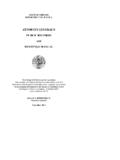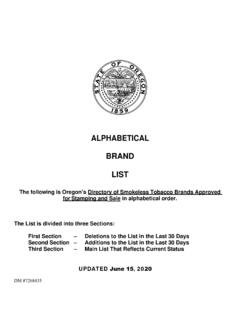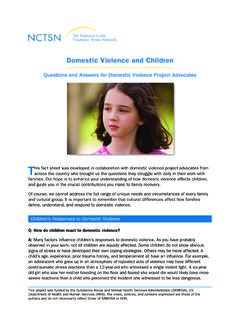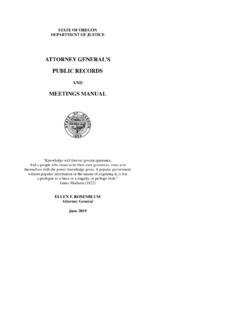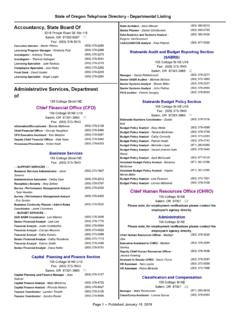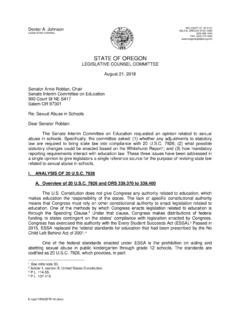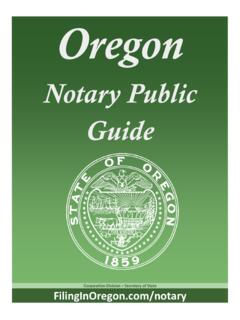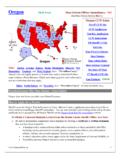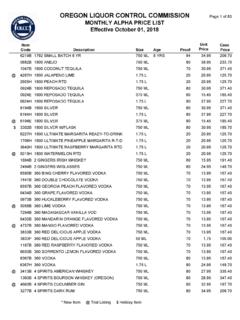Transcription of OREGON INTERVIEWING GUIDELINES - Attorney General
1 OREGON INTERVIEWING GUIDELINES THIRD EDITION 2012 OREGON Department of Justice Crime Victims Services Division Child Abuse Multidisciplinary Intervention (CAMI) Program Salem, OREGON October 2012 P a g e | 2 OREGON INTERVIEWING GUIDELINES , Third Edition Published October 2012 OREGON Department of Justice Revised, October 2012 FOREWORD The OREGON INTERVIEWING GUIDELINES (OIG) were originally developed by professionals at the request of the Health Advisory Council on Child Abuse, a group convened by the OREGON State Legislature to ensure that child abuse evaluators in OREGON were highly skilled and well-trained.
2 The OIG was published in 1998 for a target audience of assessment center based interviewers. The 2004 revision of the 1998 OREGON INTERVIEWING GUIDELINES expanded the document to address all professionals who conduct interviews with children either in child abuse assessment centers or in the field, including law enforcement officers and OREGON Department of Human Services (DHS) child welfare workers. The original edition was created by Wendy Bourg, PhD; Ray Broderick, BS; Robin Flagor, BSW; Donna Kelly, JD; Diane Ervin, LCSW; and Judy Butler, MEd.
3 The 2004 updates were provided by Sherry Bohannan, LCSW; Terry Chianello, LCSW; Robin Flagor, BSW; Jane Gallagher, Supervisor; Doug Kettner, Officer; Carl Sieg, Detective, Retired; Charles Sparks, JD; and Penny Van Ness, LCSW. The 2012 OIG is supported by updated research. A workgroup comprised of interviewers from the Child Abuse Multidisciplinary Intervention (CAMI) Program s five regional service provider centers drafted its revisions. The workgroup included Katie DeClue, LCSW, Interviewer, Mt. Emily Safe Center; Cari Dickson, BS, Interviewer, Children s Advocacy Center of Jackson County; Celeste Hasbrouck, MSW, Interviewer, KIDS Center; Katheryn Kroeger, LCSW, Interviewer, CARES NW; Nichole Satterwhite, MS, Interviewer, Kids FIRST Center; Sue Lewis, LCSW, Interviewer, formerly with CARES NW; Hope Storey, LCSW, Interviewer, formerly with KIDS Center.
4 Holly Bridenbaugh, LCSW, CARES NW, contributed Section VI, INTERVIEWING Children with Disabilities . Their expertise and dedication to the completion of this project was invaluable. The 2012 OIG benefitted from considerable assistance by: Erik Hasselman, Deputy District Attorney , Lane County Tina J. Morgan, Director, Kids FIRST Center Shelly Smith, Director, KIDS Center Marlene Mish, Director, Children s Advocacy Center of Jackson County Kathy Sewell, Director, Mt. Emily Safe Center Kevin Dowling, Director, CARES NW Joanne Southey, Deputy Chief Counsel, Civil Enforcement Division, OREGON Department of Justice Simonne Weyand, Assistant Attorney General , Child Advocacy Section, OREGON Department of Justice Stephanie Tuttle, Deputy Chief Counsel, Criminal Justice Division, OREGON Department of Justice Mike Maryanov, Child Abuse Multidisciplinary Intervention (CAMI)
5 Fund Coordinator, Crime Victims Services Division, OREGON Department of Justice Brenda George, Contract Project Manager, OREGON Network of Child Abuse Intervention Centers A special thank you goes to the OREGON Network of Child Abuse Intervention Centers for its vision, project management, and valuable input and expertise. Thanks also to the National Children s Advocacy Center and Linda Cordisco-Steele a nationally recognized expert in this field for her expertise and input, and to the Children s Justice Act Task Force for its dedication and support of this project.
6 Without Children s Justice Act funding, this project would not have been possible. The draft was also reviewed by multidisciplinary team (MDT) members including law enforcement officers, Department of Human Services child welfare workers, and prosecutors from counties across OREGON , whose input was invaluable. Each member contributed expertise to ensure that the 2012 GUIDELINES are consistent with evidence-based practice and national views of appropriate practice. P a g e | 3 OREGON INTERVIEWING GUIDELINES , Third Edition Published October 2012 OREGON Department of Justice Revised, October 2012 INTRODUCTION The primary purpose of the OREGON INTERVIEWING GUIDELINES (Third Edition 2012) is to promote consistency in the quality of care provided to those OREGON children who are interviewed for possible abuse.
7 Forensic interview practice is informed by research and practice knowledge. Regional forensic interviewers developed the GUIDELINES after a thorough research and literature review, taking their collective experience into consideration as well. These GUIDELINES have been vetted by local and national experts who support the practice recommendations suggested herein. The OREGON INTERVIEWING GUIDELINES (OIG) constitutes a guide for navigating the many levels of knowledge, practical application, and decision making involved in INTERVIEWING children about concerns of abuse.
8 Although INTERVIEWING children about possible abuse should always be grounded in scientific method, the practice of INTERVIEWING involves human interaction. Interviewers should keep in mind that there is no perfect interview and that there should be no presumed conclusions. Interviewers must be knowledgeable of practice GUIDELINES , research, child development, and use of interview tools, and they should be prepared to support their decisions in individual cases. The workgroup, prosecutors, law enforcement officers, DHS case workers and supervisors, doctors, and MSW and LCSW forensic interviewers revised the OIG in response to the current needs identified by a large number of individuals throughout the state of OREGON and to the training requirements of the National Children s Alliance Standards for Accredited Members.
9 The OIG should be considered a working document, to be updated further as researchers and practitioners expand scientific knowledge about child INTERVIEWING and child development. This 2012 edition of the OREGON INTERVIEWING GUIDELINES identifies and defines two distinct interview types (forensic and initial responder) and uses specific terminology to distinguish between these. Forensic Interviews According to the National Children s Alliance Forensic Interview standard, Forensic interviews are conducted in a manner that is legally sound, of a neutral, fact-finding nature, and coordinated to avoid duplicative INTERVIEWING .
10 Following research-based GUIDELINES will help ensure a sound process. These GUIDELINES as recognized by the members of the MDT should be monitored over time to ensure that they reflect current day practice. GUIDELINES should be developed and followed to create an interview environment that enhances free recall, minimizes interviewer influence and gathers information needed by all the MDT members involved to avoid duplication of the interview process. (See Appendix A.) The purpose of a forensic interview is to document a child s statements for use in assessing safety, criminal allegations, and treatment needs.
